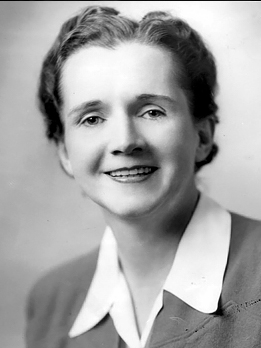Free shipping for purchases of 1.000,00 TL and above.
Rachel CARSON
Rachel Carson was born on May 27, 1907, in Springdale, Pennsylvania. She began writing at a very young age, and her first story was published in the St. Nicholas League magazine in September 1918. Her first nature essay related to bird watching was also published in the same magazine in July 1922.
In 1927, she read Alfred Lord Tennyson's poem "Locksley Hall" as part of a school assignment. Later, she would say about some lines she read in this poem: "... they spoke to something within me, suggesting that my path – which I had never seen by that time – stretched to the sea and that my fate was somehow connected with the sea.
"She graduated from the university in 1929 and was admitted to Johns Hopkins University for postgraduate studies in zoology. She had the opportunity to work at the Marine Biology Laboratory in Woods Hole for a summer.
Thanks to the efforts of her university teacher, mentor, and friend, Mary Scott Skinker, Rachel met Elmer Higgens, the director of the U.S. Fisheries Unit, which was then affiliated with the Department of Commerce. In 1935, Elmer Higgens was looking for someone to write fifty-two seven-minute radio programs for public education use in the U.S. Fisheries Unit. He started working with Rachel Carson, and when the radio programs became highly successful, he asked her to write a general introduction about marine life for a government brochure.
The first version of this essay was published as an article in the Atlantic Monthly magazine. This article later evolved into the book "Under the Sea-Wind", and Oxford University Press published it in 1941, on the eve of World War II. Her second book, "The Sea Around Us," was published in 1951 and was selected as the year's most striking book by the New York Times. This book was followed by "The Edge of the Sea" in 1955. This book also remained on the New York Times bestseller list for nearly five months.
By 1957, some state departments and federal offices had started a DDT application against mosquitoes on private lands. Carson's friend and correspondent, Olga Hutchins, had an extensive bird sanctuary at her home in Duxbury, Massachusetts. She wrote to Carson about the death of many songbirds and the poisoning of nests, lakes, and bird pools due to repeated pesticide applications. Carson dedicated the next four years to research on the proper and improper use of agricultural pesticides.
When the New York Times published its list of the 100 most important books of the 20th century, "Silent Spring" was ranked second. It has been translated into numerous languages, and new translations continue to be published almost every year.
Rachel Carson left us a legacy that not only embraces the future of life but also ensures the continuation of the human spirit. She wrote, "As we focus more clearly on the wonders and truths of the universe around us, our desire to destroy our race will decrease accordingly. Awe and humility are virtuous feelings... they cannot coexist with a desire for destruction."
